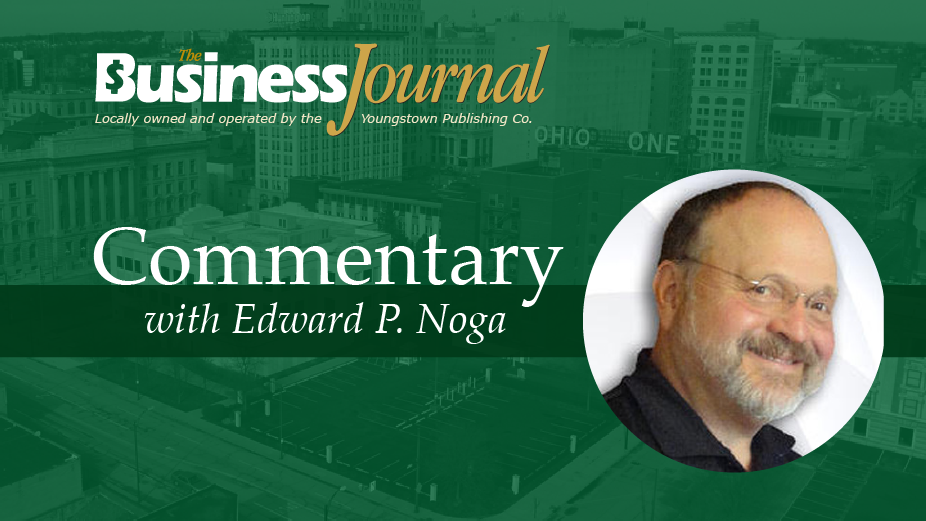By Edward P. Noga
This column pertains to where I live currently. My thoughts can fit the smallest town in our Valley as well as the largest city. As you read about where I live, know that you can insert where you live and more than likely conjure up similar stories and experiences and pictures about where you call home.
So, our Business Journal growth report needs two issues. That’s good! As we highlight the companies and entities that make up our Valley, may we be grateful for all those who truly know what it means to have “quality of life.”
When I hear “growth” in relation to our communities, my memory bank goes back to former Youngstown Mayor Jay Williams, who spoke often about our need to learn what it means to grow smaller.
Our Valley rose to great heights in the midst of a huge worldwide industrial need; then we were dealt a serious and almost deadly hand.
That chapter in our history began in the late 1970s, and is a collection of setbacks and broken promises that brought grief to us all. Now, as we make the transition from Rust Belt to Voltage Valley, we are dealing with different demographics and realities that will affect our growth.
We have learned the hard lesson that bigger or biggest doesn’t necessarily mean best, that the strengths of our Valley can enable us to be what we will be regardless of our population. As Mayor Jay would say, we can and will grow. But it will be different.
Which brings me to the advent of LED lighting and how it has changed how we light up our homes. I am not looking to be a salesman for LED lighting. But I do have some observations that highlight an offshoot of this modern, energy-saving marvel.
In my youth, we were often drawn to new businesses and events by nighttime sky piercing searchlights that shot a beam high into the night sky. You could see it everywhere and it drew attention. The light heralded a new business, a fair or festival, a concert or community gathering.
In recent years, LED lighting has highlighted new, renovated or restored buildings, bridges and other assets. I remember the Realty Tower in Central Square in Youngstown being repurposed for apartment living. When completed, it was highlighted and lit up with LED spotlights shooting up the sides of the building. It commanded attention that something new and good and important had transformed the building.
When the Mahoning County Courthouse was restored, the process included lighting up the exterior of the structure built in 1908.
Our new downtown hotel was rescued from demolition and now shines to welcome visitors. Add to this list the renaming and rebranding of the former Home Savings and Loan tower on West Federal Street. It has always been lighted at night. But now it gleams with new lighting as it takes its place as a new bank.
Now, our main library on Wick Avenue, the long-vacant former Legal Arts Center across from the courthouse, Stambaugh Auditorium near Wick Park and several new campus housing complexes are shouting out their presence with enhanced lighting.
In the past several weeks, the recently purchased Chase Tower on the square and the Penguin City Brewery on the east end of downtown have joined the list of renovation, repurposing and restoration. All are using enhanced lighting to let us know that something new is happening.
Granted, new lighting doesn’t mean success. But new lighting technology has certainly become a novel and featured addition in our communities.
It might be in new signage or a brighter parking area. It might be highlighting a new or repurposed building. Many of our community parks have been illuminated tremendously. It does command attention.
I remember the excitement when the underside of the Market Street Bridge was lighted with many colors that change with the seasons or holidays. It helped to light up a long-neglected area and it also pointed to the Mahoning River.
An evening drive by or near the bridge is now a bright experience that shows what can happen when dreams turn into plans and are followed up with timelines, funding and community input.
Growth does happen and needs to be encouraged in the midst of the realities that sometimes drag us down.
The two-edition Growth Report is a reminder of what can happen and does happen. Yes, the report is a recap of what was accomplished in the last year. It is a chronicle of the challenges facing our business community.
But it is a reminder that proposals and plans add to the quality of life here. Not every project is a success. But there are many that light our way to a better future for those following us who will call this area home.
